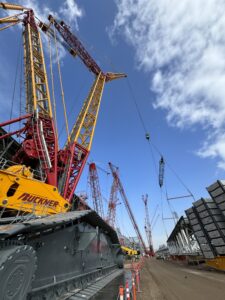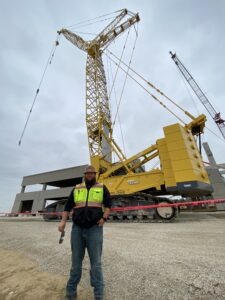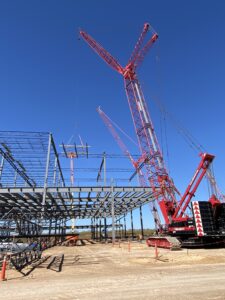 Welcome to our blog post on the crucial role of lift directors and OSHA’s guidelines for crane lifts on construction sites! If you’ve ever marveled at the impressive sight of a towering crane effortlessly maneuvering heavy loads, you might not be aware of the meticulous planning and coordination required behind the scenes. In this article, we will delve into why lift directors play such a vital role in ensuring safety during crane operations and how adhering to OSHA’s and ASME’s guidelines can prevent accidents and save lives. So, buckle up as we explore this fascinating world where precision meets precaution!
Welcome to our blog post on the crucial role of lift directors and OSHA’s guidelines for crane lifts on construction sites! If you’ve ever marveled at the impressive sight of a towering crane effortlessly maneuvering heavy loads, you might not be aware of the meticulous planning and coordination required behind the scenes. In this article, we will delve into why lift directors play such a vital role in ensuring safety during crane operations and how adhering to OSHA’s and ASME’s guidelines can prevent accidents and save lives. So, buckle up as we explore this fascinating world where precision meets precaution!
Introduction to Lift Directors and their Role in Crane Lifts on Construction Sites
In the construction industry, crane lifts are a common sight on almost every job site. These heavy machines are essential for lifting and moving materials, equipment, and even workers to different levels of a building or construction site. However, with such powerful machinery comes great responsibility. To ensure safe operations during crane lifts, the Occupational Safety and Health Administration (OSHA) has established guidelines that must be followed by all construction companies.
One of the key roles in these guidelines is that of a lift director. According to ASME B30.5, the Lift Director is required to be a qualified individual. Qualified “means a person who, by possession of a recognized degree, certificate, or professional standing, or who by extensive knowledge, training and experience, successfully demonstrated the ability to solve/resolve problems relating to the subject matter, the work, or the project.”
Responsibilities of a Lift Director
The primary responsibility of a lift director is to plan, coordinate, supervise, and oversee all activities related to crane lifts. This includes identifying potential hazards before the lift begins and implementing measures to prevent accidents from occurring. The lift director must also ensure that all personnel involved in the operation are properly trained and certified to operate cranes safely.
Before any lift takes place, it is the duty of the lift director to conduct thorough pre-lift meetings with all involved parties. This includes crane operators, riggers, signal persons, spotters, and anyone else who will be working near or around the crane during the operation. During these meetings, potential risks are identified, safety protocols are reviewed, communication procedures are established, and emergency plans are discussed. Additionally, a Lift Director is responsible for:
- Reviewing and implementing the lift plan
- Ensuring compliance when working near power lines or lifting personnel
- Ensuring the load rigging is performed by a qualified rigger
- Confirming that the proper traffic controls are implemented
- Stopping crane operations if warned of unsafe conditions
- Confirming the loads weight prior to lifting
- Ensuring the load is balanced and rigged properly
- Holding pre-lift meetings
- Confirming all set-up preparations are according to the lift plans
- Conducting a post-lift review
During the actual lift process itself, it is crucial for the lift director to maintain constant communication with all personnel involved. They must also monitor weather conditions closely as strong winds can significantly affect crane stability.
After each successful lift is completed, it is still important for the lift director to remain vigilant until everything has been safely secured back into place. Once everything has been properly stored and secured, the lift director may then review the operation to identify any areas for improvement in future lifts.
Preparing for a Critical Lift: Factors to Consider and Checklists to Follow
OSHA defines a critical lift as any lift that (1) exceeds 75 percent of the rated capacity of the crane or derrick, or (2) requires the use of more than one crane or derrick.
Preparing for a critical lift is an essential aspect of ensuring the safety and success of crane lifts on construction sites. It involves careful planning, thorough inspections, and effective communication among all parties involved in the lift operation. In this section, we will discuss the factors that should be considered when preparing for a critical lift and provide checklists to follow to ensure a smooth and safe lifting process.
1. Site Assessment:
The first step in preparing for a critical lift is to conduct a site assessment. This involves evaluating the ground conditions, access points, potential obstacles or hazards, and any other relevant factors that could affect the lift operation. The information gathered from this assessment will help determine the appropriate equipment needed for the lift and identify any additional safety measures that may be required
2. Crane Selection:
Selecting the right crane for a critical lift is crucial as it directly impacts its safety and efficiency. The type of crane chosen depends on various factors such as load weight, reach, terrain, weather conditions, etc. It is essential to consult with qualified professionals or refer to manufacturer’s specifications when determining which crane would be most suitable for the specific lift.
3. Rigging Plan:
A rigging plan outlines how loads will be lifted using cranes and includes details such as load weight distribution, rigging configuration, attachment points on both the load and crane, etc. A detailed rigging plan should be developed before conducting any critical lifts to ensure proper execution and minimize risks associated with improper rigging.
4. Personnel Training:
All personnel involved in a critical lift must have adequate training on safe lifting practices according to OSHA guidelines. This includes operators, signal persons/flaggers, spotters/riggers, supervisors/managers overseeing the operation, etc. Properly trained personnel are better equipped to handle any unexpected situations during lifting operations safely.
5. Monitor Environmental Conditions:
Environmental conditions can significantly impact lifting operations. Lift Directors should monitor factors such as wind speed, precipitation, and visibility to determine if it is safe to proceed with lifting activities. If adverse weather conditions or other environmental hazards pose a risk, the Lift Director should postpone the operation until conditions improve.
6. Establish Clear Communication:
Clear and effective communication is vital for successful lifting operations. Lift Directors should ensure that all personnel involved in the lift, including crane operators, signal persons, and riggers, understand their roles and responsibilities. Establishing a reliable communication system, such as hand signals or two-way radios, is crucial to maintain constant and accurate communication throughout the operation.
7. Checklists:
Checklists serve as useful tools in ensuring that all necessary precautions have been taken before conducting a critical lift. Some of the items that should be included in these checklists are:
– Verify crane certification and inspection records
– Check rigging equipment for wear and tear or damage
– Perform pre-lift inspections on the crane and load
– Review communication procedures between personnel involved in the lift operation
– Confirm ground conditions and ensure proper access routes are established
– Evaluate weather conditions and make adjustments if needed
Preparing for a critical lift is a complex process that requires careful planning, thorough assessments, and proper communication among all parties involved. By following these guidelines and using checklists as a reference, lift directors can ensure safe lifting operations on construction sites.
Conclusion:
Lift Directors play a pivotal role in maintaining a safe and compliant construction site. By understanding their responsibilities, conducting thorough planning and risk assessments, establishing clear communication, verifying equipment safety, monitoring environmental conditions, implementing training programs, and regularly inspecting lift plans, Lift Directors can ensure the safety and well-being of workers and promote a culture of compliance on OSHA construction sites. By following these best practices, we can work together to create a safer and more productive construction industry.
Remember, safety is a shared responsibility, and every individual involved in lifting operations has a role to play in creating a secure work environment. By prioritizing safety and adhering to OSHA guidelines, we can prevent accidents, protect lives, and contribute to the success of construction projects.
Author:Bryan McClure

No comment yet, add your voice below!